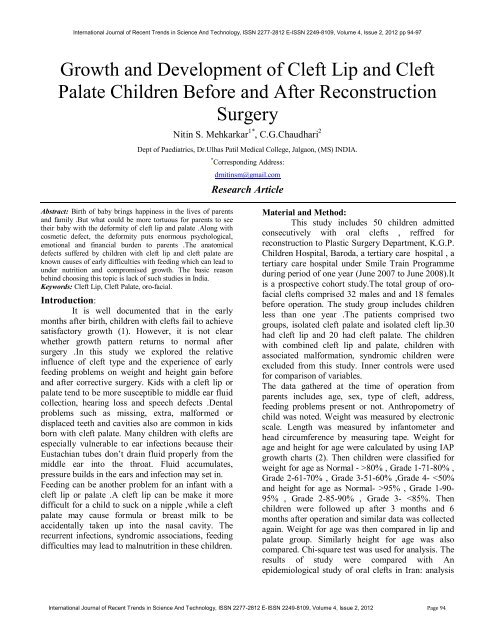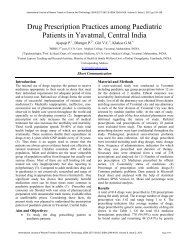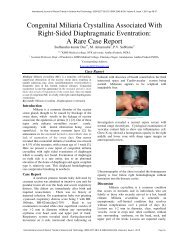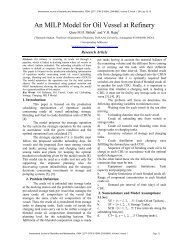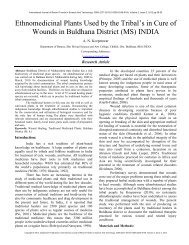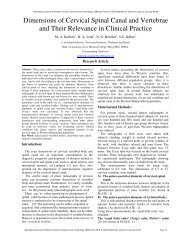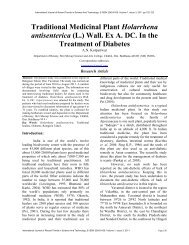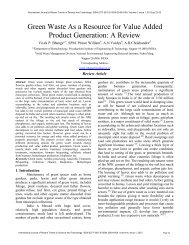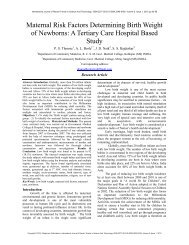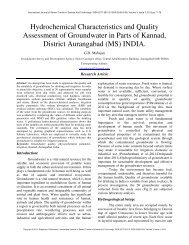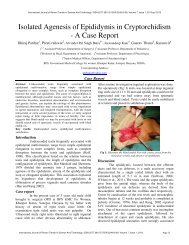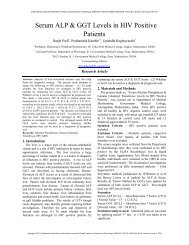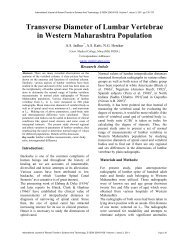Growth and Development of Cleft Lip and Cleft Palate ... - Statperson
Growth and Development of Cleft Lip and Cleft Palate ... - Statperson
Growth and Development of Cleft Lip and Cleft Palate ... - Statperson
You also want an ePaper? Increase the reach of your titles
YUMPU automatically turns print PDFs into web optimized ePapers that Google loves.
International Journal <strong>of</strong> Recent Trends in Science And Technology, ISSN 2277-2812 E-ISSN 2249-8109, Volume 4, Issue 2, 2012 pp 94-97<br />
<strong>Growth</strong> <strong>and</strong> <strong>Development</strong> <strong>of</strong> <strong>Cleft</strong> <strong>Lip</strong> <strong>and</strong> <strong>Cleft</strong><br />
<strong>Palate</strong> Children Before <strong>and</strong> After Reconstruction<br />
Surgery<br />
Nitin S. Mehkarkar 1* , C.G.Chaudhari 2<br />
Dept <strong>of</strong> Paediatrics, Dr.Ulhas Patil Medical College, Jalgaon, (MS) INDIA.<br />
* Corresponding Address:<br />
drnitinsm@gmail.com<br />
Research Article<br />
Abstract: Birth <strong>of</strong> baby brings happiness in the lives <strong>of</strong> parents<br />
<strong>and</strong> family .But what could be more tortuous for parents to see<br />
their baby with the deformity <strong>of</strong> cleft lip <strong>and</strong> palate .Along with<br />
cosmetic defect, the deformity puts enormous psychological,<br />
emotional <strong>and</strong> financial burden to parents .The anatomical<br />
defects suffered by children with cleft lip <strong>and</strong> cleft palate are<br />
known causes <strong>of</strong> early difficulties with feeding which can lead to<br />
under nutrition <strong>and</strong> compromised growth. The basic reason<br />
behind choosing this topic is lack <strong>of</strong> such studies in India.<br />
Keywords: <strong>Cleft</strong> <strong>Lip</strong>, <strong>Cleft</strong> <strong>Palate</strong>, oro-facial.<br />
Introduction:<br />
It is well documented that in the early<br />
months after birth, children with clefts fail to achieve<br />
satisfactory growth (1). However, it is not clear<br />
whether growth pattern returns to normal after<br />
surgery .In this study we explored the relative<br />
influence <strong>of</strong> cleft type <strong>and</strong> the experience <strong>of</strong> early<br />
feeding problems on weight <strong>and</strong> height gain before<br />
<strong>and</strong> after corrective surgery. Kids with a cleft lip or<br />
palate tend to be more susceptible to middle ear fluid<br />
collection, hearing loss <strong>and</strong> speech defects .Dental<br />
problems such as missing, extra, malformed or<br />
displaced teeth <strong>and</strong> cavities also are common in kids<br />
born with cleft palate. Many children with clefts are<br />
especially vulnerable to ear infections because their<br />
Eustachian tubes don’t drain fluid properly from the<br />
middle ear into the throat. Fluid accumulates,<br />
pressure builds in the ears <strong>and</strong> infection may set in.<br />
Feeding can be another problem for an infant with a<br />
cleft lip or palate .A cleft lip can be make it more<br />
difficult for a child to suck on a nipple ,while a cleft<br />
palate may cause formula or breast milk to be<br />
accidentally taken up into the nasal cavity. The<br />
recurrent infections, syndromic associations, feeding<br />
difficulties may lead to malnutrition in these children.<br />
Material <strong>and</strong> Method:<br />
This study includes 50 children admitted<br />
consecutively with oral clefts , reffred for<br />
reconstruction to Plastic Surgery Department, K.G.P.<br />
Children Hospital, Baroda, a tertiary care hospital , a<br />
tertiary care hospital under Smile Train Programme<br />
during period <strong>of</strong> one year (June 2007 to June 2008).It<br />
is a prospective cohort study.The total group <strong>of</strong> or<strong>of</strong>acial<br />
clefts comprised 32 males <strong>and</strong> <strong>and</strong> 18 females<br />
before operation. The study group includes children<br />
less than one year .The patients comprised two<br />
groups, isolated cleft palate <strong>and</strong> isolated cleft lip.30<br />
had cleft lip <strong>and</strong> 20 had cleft palate. The children<br />
with combined cleft lip <strong>and</strong> palate, children with<br />
associated malformation, syndromic children were<br />
excluded from this study. Inner controls were used<br />
for comparison <strong>of</strong> variables.<br />
The data gathered at the time <strong>of</strong> operation from<br />
parents includes age, sex, type <strong>of</strong> cleft, address,<br />
feeding problems present or not. Anthropometry <strong>of</strong><br />
child was noted. Weight was measured by electronic<br />
scale. Length was measured by infantometer <strong>and</strong><br />
head circumference by measuring tape. Weight for<br />
age <strong>and</strong> height for age were calculated by using IAP<br />
growth charts (2). Then children were classified for<br />
weight for age as Normal - >80% , Grade 1-71-80% ,<br />
Grade 2-61-70% , Grade 3-51-60% ,Grade 4- 95% , Grade 1-90-<br />
95% , Grade 2-85-90% , Grade 3-
Nitin S. Mehkarkar, C.G.Chaudhari<br />
<strong>of</strong> 1669 cases, which was a 15- year cross sectional<br />
study from 1976 to September 1991 (3).<br />
Results:<br />
Sample pr<strong>of</strong>ile on admission<br />
Total number <strong>of</strong> patients N=50<br />
Table no.1<br />
Variable N % <strong>of</strong> N<br />
Gender<br />
Male 32 64%<br />
Female 18 36%<br />
Type <strong>of</strong> cleft<br />
<strong>Cleft</strong> lip 30 60%<br />
<strong>Cleft</strong> palate 20 40%<br />
Weight for age<br />
Normal 12 24%<br />
Grade 1 20 40%<br />
Grade 2 13 26%<br />
Grade 3 5 10%<br />
Height for age<br />
Normal 27 54%<br />
Grade 1 21 42%<br />
Grade 2 2 4%<br />
Comment: This study includes total 50 patients less than one<br />
year <strong>of</strong> age. There was a high male preponderance. Male : female<br />
ratio was 1:0.56 as compared to national male to female ratio<br />
1:0.918 for 0-6 year(5).Group comprised <strong>of</strong> 60% cleft lip patients<br />
<strong>and</strong> 40% cleft palate patients. In anthropometry measurements,<br />
weight for age, 40% children fall in Grade-1 malnutrition, 26% in<br />
Grade-2 malnutrition, 24% in Normal variety <strong>and</strong> 10% in Grade-<br />
3 malnutrition. Thus weight is affected in cleft patients. In height<br />
for age category, 54% children were in Normal variety, 42% in<br />
Grade-1<strong>and</strong> 4% in Grade -2.<br />
Number<br />
<strong>of</strong><br />
Patients<br />
50<br />
Table no 2: Patients on follow up<br />
On Admission After 3<br />
(before<br />
operation)<br />
months<br />
<strong>of</strong> surgery<br />
(1 st followup)<br />
45(90%<strong>of</strong><br />
admission)<br />
After 6 months<br />
<strong>of</strong> surgery<br />
(2 nd follow-up)<br />
35 (70%<strong>of</strong><br />
admission)<br />
Comment: The total number <strong>of</strong> patients reduced to 90% <strong>of</strong><br />
before surgery after 3 months with first follow up, on second<br />
follow up six months after operation reduced to 70%.<br />
Table no 3: Comparison <strong>of</strong> type <strong>of</strong> cleft<br />
Type <strong>of</strong> cleft Present<br />
Study(N=50)<br />
Iranian<br />
Study(N=1669)<br />
<strong>Cleft</strong> lip 30(60%) 543(34%)<br />
<strong>Cleft</strong> palate 20(40%) 281(16.83%)<br />
Comment: In previous study combined lip <strong>and</strong> palate group was<br />
predominant <strong>and</strong> second common was lip <strong>and</strong> in our study we<br />
excluded combined group <strong>and</strong> commonest group is lip.<br />
Table no 4: Weight for age<br />
Normal Grade 1 Grade 2 Grade 2<br />
On admission 12(40%) 20(40%) 13(26%) 5(10%)<br />
3 months 24(55.6%) 12(24.4%) 6(15.6%) 3(4.4%)<br />
6 months 32(91.4%) 2(5.7%) 19(2.9%) 0<br />
Comment: Weight for age improved gradually after surgery.<br />
Before operation the children in normal weight age category were<br />
24% <strong>and</strong> they increased to 91% after six months <strong>of</strong> operation.<br />
Improvement in weight:<br />
100<br />
90<br />
80<br />
70<br />
60<br />
50<br />
40<br />
30<br />
20<br />
10<br />
0<br />
Chi-square test for Weight measurements<br />
degree <strong>of</strong> P<br />
Value<br />
freedom value<br />
Pearson Chi-<br />
38.052 6 0.000<br />
square tests:<br />
Comment: P value is significant so weight gain is significant<br />
after surgery.<br />
Table no 5: Weight for age<br />
<strong>Cleft</strong> lip<br />
Normal Grade 1 Grade 2 Grade 3<br />
On admission 12(40%) 14(46.7%) 3(10%) 1(3.3%)<br />
3 months 20(80%) 3(12%) 2(8%) 0<br />
6 months 18(100%) 0 0 0<br />
<strong>Cleft</strong> palate<br />
Normal Grade 1 Grade 2 Grade 3<br />
On admission 0 6(30%) 10(50%) 4(20%)<br />
3 months 5(25%) 8(40%) 5(25%) 2(10%)<br />
6 months 14(82.4%) 2(11.8%) 1(5.9%) 0<br />
Comment: In cleft lip children, normal group comprised 40%<br />
while in palate group 0% children were in normal weight for age<br />
group.This shows that malnutrition is more in palate group.<br />
Chi-square test:<br />
normal PEM grade 1 PEM grade 2 PEM grade 3<br />
Calculated<br />
valve<br />
Degree <strong>of</strong><br />
freedom<br />
P<br />
value<br />
Pearson chi-square<br />
22.398 6 0.001<br />
in lip group<br />
Pearson chi-square<br />
0.000<br />
31.964 6<br />
in palate group<br />
Comment: P value is significant both in palate <strong>and</strong> lip group so<br />
weight gain is significant in both groups after surgery.<br />
admission<br />
3 months<br />
6 months<br />
Copyright © 2012, <strong>Statperson</strong> Publications, International Journal <strong>of</strong> Recent Trends in Science And Technology, ISSN 2277-2812 E-ISSN 2249-8109, Volume 4, Issue 2, 2012
International Journal <strong>of</strong> Recent Trends in Science And Technology, ISSN 2277-2812 E-ISSN 2249-8109, Volume 4, Issue 2, 2012 pp 94-97<br />
Table no 6: Height for age<br />
Normal Grade 1 Grade 2<br />
On admission 27(54%) 21(42%) 2(4%)<br />
3 months 33(73%) 11(24.4%) 1(2.9%)<br />
6 months 34(97.1%) 1(2.9%) 0<br />
Comment: Height for age in cleft children- 54% were in normal<br />
group, 42% in Grade-1 <strong>and</strong> 4% children in Grade-2. After<br />
operation, at 3 months, normal group comprised 73% , 24.4% in<br />
Grade-1 <strong>and</strong> 2.95 in Grade-2. After 6 months, about 97% patients<br />
were in normal category.<br />
Chi-square test:<br />
Calculated Degree <strong>of</strong> P value<br />
value freedom<br />
Pearson 19.190 4 0.001<br />
chi-square<br />
Comment: P value was significant so height improvement<br />
noticed after surgery in both cleft lip <strong>and</strong> palate group is<br />
significant.<br />
Improvement in height:<br />
120<br />
100<br />
80<br />
60<br />
40<br />
20<br />
0<br />
54<br />
73<br />
97.1<br />
42<br />
24.4<br />
2.9 4 2.2 0<br />
normal grade 1 grade 2<br />
ADDMISSION<br />
3 months<br />
6 months<br />
Table no.7: Height for age<br />
<strong>Cleft</strong> lip<br />
Normal Grade 1 Grade 2<br />
On admission 24(80%) 6(20%) 18(100%)<br />
3 Months 22(88%) 3(12%) 0<br />
6 months 18(100%) 0 0<br />
<strong>Cleft</strong> palate<br />
Normal Grade1 Grade 2<br />
On admission 3(15%) 15(75%) 2(10%)<br />
3 months 11(55%) 8(40%) 1(5%)<br />
6 months 16(94.1%) 1(5.9%) 0<br />
Comment: In lip group, 80% children were in normal range<br />
while in palate group only 15% in normal range so we can<br />
conclude that height is more affected in palate group.<br />
Chi –square test:<br />
Calculated Degree <strong>of</strong> P<br />
value freedom Value<br />
Pearson chi - square 4.167 2 0.124<br />
in lip group<br />
Pearson chi –square 23.170 4 0.000<br />
in palate group<br />
Comment: P value is not significant in lip group that means<br />
height was not significantly affected, while in palate group P<br />
value is significant so height improvement was significant.<br />
Discussion:<br />
The study was undertaken with objectives<br />
<strong>of</strong> to study growth <strong>and</strong> psychosocial <strong>and</strong> motor<br />
development <strong>of</strong> cleft lip <strong>and</strong> cleft palate children<br />
before <strong>and</strong> after reconstruction surgery. The basic<br />
reason behind this study is lack <strong>of</strong> such studies in<br />
India .The study was done at K.G.P. Children<br />
Hospital , Vadodara, a tertiary care centre running<br />
smile train programme. It is a prospective cohort<br />
study . It includes 50 children less than one year <strong>of</strong><br />
age <strong>and</strong> had cleft lip or cleft palate but combined<br />
palate <strong>and</strong> lip , syndromic babies excluded from<br />
study .Out <strong>of</strong> 50 children, 30 were cleft lip <strong>and</strong> 20<br />
were cleft palate. On admission, weight ,height <strong>and</strong><br />
head circumference were measured .Using IAP<br />
growth charts, weight for age ,height for age were<br />
calculated <strong>and</strong> grading malnutrition was done.<br />
<strong>Cleft</strong> children especially cleft palate have feeding<br />
problems like regurgitation <strong>of</strong> feeding , recurrent<br />
infections which leads to failure to thrive in these<br />
children .Children were followed up after 3 <strong>and</strong> 6<br />
months <strong>of</strong> reconstruction surgery <strong>and</strong> similar data<br />
regarding height ,weight , head circumference <strong>and</strong><br />
development were noted.<br />
Observations:<br />
The children included in this study comprises<br />
64% male <strong>and</strong> 36% female.Thus male predominance<br />
was observed in study.This may be due to male<br />
predominance in cleft as WHO report .This study<br />
reveals that all children with clefts have a tendency to<br />
growth faltering.Height <strong>and</strong> weight for age both get<br />
affected due to cleft deformity.<br />
The isolated palate group has more compromised<br />
growth than lip as shown in this study <strong>and</strong> previous<br />
studies .All cleft types showed catch up after surgery<br />
to centile positions close to those predicted for<br />
normal children, a finding that has been described in<br />
a previous study also (8).<br />
It is not hard to explain the growth faltering seen,<br />
since a large proportion <strong>of</strong> the children in the study<br />
population experienced early feeding difficulties<br />
which were <strong>of</strong>ten prolonged <strong>and</strong> multiple. It would<br />
seem desirable that appropriate <strong>and</strong> timely dietary<br />
advice be given , possibly by involving a dietician in<br />
the interdisciplinary surgical team. Certainly the<br />
height <strong>and</strong> weight <strong>of</strong> cleft palate children should be<br />
routinely recorded when they attend the outpatient<br />
clinic to allow for prompt identification <strong>of</strong> a growth<br />
deficit, so that appropriate action can be taken (9).<br />
The presence <strong>of</strong> a syndrome did appear to be<br />
International Journal <strong>of</strong> Recent Trends in Science And Technology, ISSN 2277-2812 E-ISSN 2249-8109, Volume 4, Issue 2, 2012 Page 96
Nitin S. Mehkarkar, C.G.Chaudhari<br />
important in predicting height achievement, an<br />
observation that has been made previously (7). But in<br />
this study we have excluded syndromic babies <strong>and</strong><br />
combined palate <strong>and</strong> lip group.<br />
In this study we compared results with Iranian<br />
study(3). Iranian study was epidemiological study <strong>of</strong><br />
oral clefts , analysis <strong>of</strong> 1669 cases. The study was<br />
done at Shiraz , Iran.The study was 15 year cross<br />
sectional (prevalence) study from 1976 to<br />
1991.While comparing the gender distribution, a fact<br />
revealed that males dominated in both studies with<br />
64% in present study <strong>and</strong> 57.2% in Iranian study. The<br />
male : female ratio was found to be 1:0.560 <strong>and</strong><br />
1:0.746 in present <strong>and</strong> Iranian study respectively. The<br />
results probably are a strog indication that males are<br />
affected more in or<strong>of</strong>acial clefts as is also indicated<br />
by WHO reports.<br />
The combined lip <strong>and</strong> palate group<br />
predominated 50.62% in Iranian study <strong>and</strong> second<br />
commonest was lip group while in our study we<br />
excluded combined group <strong>and</strong> lip group<br />
predominated.<br />
After 3 months, sample size reduced to 45 <strong>and</strong><br />
after 6 months only 35 children came foe follow –up<br />
.The reasons behind drop <strong>of</strong> number <strong>of</strong> patients for<br />
follow-up may be female sex, illiteracy ,low family<br />
income ,<strong>and</strong> distance from hospital .The weight for<br />
age after 6 months for normal variety increased from<br />
24% before operation to 91% after operation .The<br />
height for age measurements in normal variety<br />
increased from 54% to 97% after 6 months.Thus<br />
height <strong>and</strong> weight both recovered after opration.<br />
Conclusion:<br />
Weight <strong>and</strong> height faltering is commonly<br />
seen in children with cleft but this is <strong>of</strong> a short-term<br />
nature. Following reparative surgery, catch-up is<br />
shown by children with all cleft types <strong>and</strong> there is no<br />
lasting effect on either weight or attained height.<br />
Although the weight faltering is a temporary<br />
phenomenon, it is likely to cause great anxiety to<br />
parents, who might benefit from a more proactive<br />
attempt to <strong>of</strong>fer dietary advice <strong>and</strong> support in the<br />
early weeks <strong>of</strong> their child’s life.<br />
Suggestions for Future Work:<br />
1. Looking at the paucity <strong>of</strong> Indian data with<br />
regards to oro-facial clefts, we need to have<br />
more population based studies to ascertain<br />
the true incidence <strong>and</strong> prevalence <strong>of</strong> or<strong>of</strong>acial<br />
clefts since accurate data on<br />
epidemiology is important for documenting<br />
the burden in relation to planning <strong>of</strong> public<br />
health service.<br />
2. In future, all groups <strong>of</strong> cleft palate <strong>and</strong> or lip<br />
can be studied also including syndromic<br />
babies so as to decide whether syndromes<br />
really affect the growth <strong>of</strong> these babies or<br />
not.<br />
3. Since the quality <strong>of</strong> life <strong>of</strong> children with<br />
clefts is affected considerably, there is need<br />
for public awareness regarding the<br />
availability <strong>of</strong> surgical treatment <strong>and</strong> early<br />
intervention.<br />
4. Study containing large sample size is<br />
advisable for future <strong>and</strong> speech should also<br />
be studied well before <strong>and</strong> after surgery.<br />
References:<br />
[1] Avedian L, Ruberg R. Impaired weight gain in cleft<br />
palate infants.<strong>Cleft</strong> <strong>Palate</strong> J., 17:24-26, 1980.<br />
[2] KhadilkarV.V.,Khadilkar A.V., Shah N., Agarwal K.N.<br />
IAP <strong>Growth</strong> Monitoring guidelines from birth to 18<br />
years. Indian Pediatr., 44:187-198, 2007.<br />
[3] Hossain M., Sherkat M. An epidemiologic study <strong>of</strong> oral<br />
clefts in Iran:Analysis <strong>of</strong> 1669 cases. <strong>Cleft</strong> <strong>Palate</strong><br />
Crani<strong>of</strong>ac J., 37:2191-2196, 2000.<br />
[4] Lee J, Nunn J, Wright C. Arch DIs Child .1997; Height<br />
<strong>and</strong> weight achievement in cleft lip <strong>and</strong> palate,<br />
76(1):70-72, 1997.<br />
[5] National family health survey -3 vol 1, 21, 2005-2006.<br />
[6] Jones W. Weight gain <strong>and</strong> feeding in the neonate with<br />
cleft –a 3 center study.<strong>Cleft</strong> <strong>Palate</strong> J., 25:379-384,<br />
1988.[Medline]<br />
[7] Jensen B, Kreiborg S, Dahl E, Fogh –Anderson P. <strong>Cleft</strong><br />
lip <strong>and</strong> palate in Denmark 1976-1981.Epidemiology,<br />
variability <strong>and</strong> early somatic development .<strong>Cleft</strong> <strong>Palate</strong><br />
J., 25:258-269, 1988. [Medline]<br />
[8] Hunter W, Di J, Man D. The timing <strong>of</strong> height <strong>and</strong><br />
weight deficits in twins discordant for cleft lip <strong>and</strong> /or<br />
palate J., 14:158, 1977. [Medline]<br />
[9] Bowers E, Mayro R, Whitaker L. General body growth<br />
in children with cleft <strong>of</strong> the lip, palate <strong>and</strong> crani<strong>of</strong>acial<br />
structure.Sc<strong>and</strong> J Plast Reconstr Surg., 21:7-14, 1987.<br />
Copyright © 2012, <strong>Statperson</strong> Publications, International Journal <strong>of</strong> Recent Trends in Science And Technology, ISSN 2277-2812 E-ISSN 2249-8109, Volume 4, Issue 2, 2012


